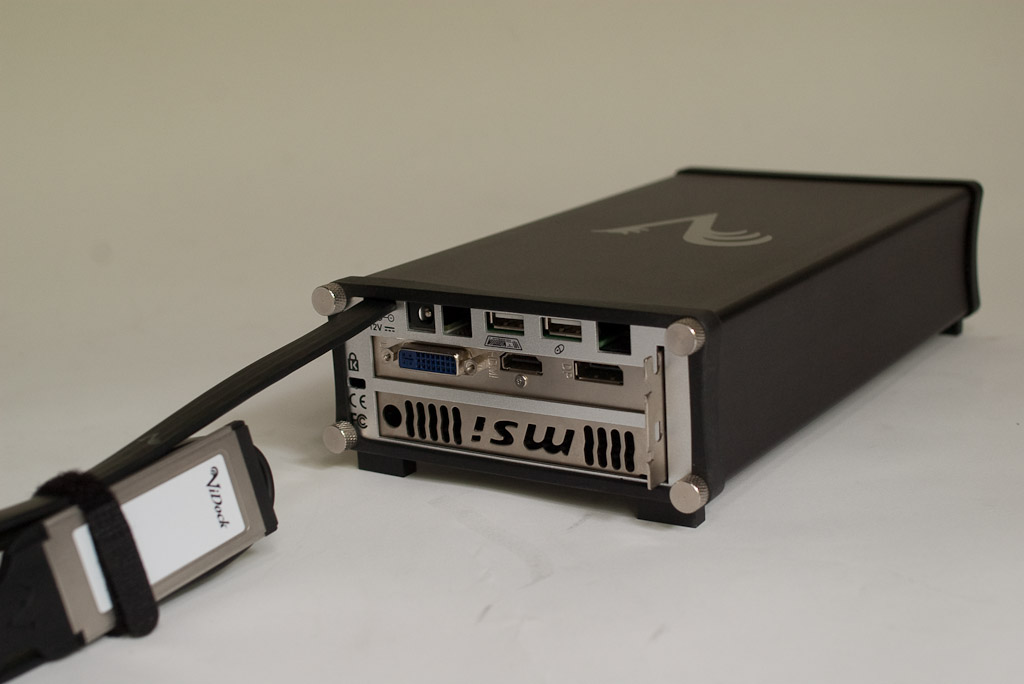External Thunderbolt Graphics Adapter in the Works
Village Instruments is currently working on a Thunderbolt version of its ViDock external graphics card chassis.
Last week Village Instruments used its Facebook page to poll customers about a Thunderbolt version of its ViDock expansion for the PC and Mac platforms. The post claimed that if more than fifty people posted a comment in favor of the device, then development would commence. So far 509 people have responded.
"ViDock Thunderbolt is a go!" said CEO Hubert Chen last week. "Thank you to everybody in this wonderful community! Special thanks to Manu Marea, Nino Ri and Jim Atchue! My in boxes are flooded. Please allow me a day or two to get back to everybody and to work with engineering and production to make a project schedule for ViDock Thunderbolt."
For the uninitiated, ViDock could likely be the answer for many laptop gamers who simply can't afford to purchase the more expensive gamer-oriented configurations. ViDock is essentially an extension chassis that connects to a laptop via an ExpressCard slot and allows the consumer to use a discrete PCI Express-graphics card. Of course, this doesn't help in dealing with upgrading the CPU at a later date, but at least the current laptop can be extended a few more years simply by swapping out the external graphics card for something newer.
"ViDock is not only compatible with Windows 7 but takes full advantage of its latest features," reads the product description. "Windows 7 instantly remembers and restores your display configurations when you hot plug your ViDock then again when you gracefully remove ViDock. No need to go into the display set-up dialog box to configure your displays. Also, with Windows 7, the graphics card in ViDock will show up in the eject tray as a removable device. ViDock also works with Vista, Windows XP, and Mac OS X."
According to the company, a laptop can connect to a large format display (or two), keyboard, and mouse with just one cable. The chassis also features a 2-port USB hub that allows the user to add more devices to the one-step plug-in such as a printer, external hard drive, USB headset, and more.
Currently Village Instruments is offering three versions of its ViDock device: the ViDock 3 for cards that consume up to 75W of power, the ViDock 4 for higher performance cards requiring up to 150W of power and use a 6-pin power connector, and the ViDock 4 Plus which includes a second 2 x 3 pin power connector for cards that leech up to 225W of power.
But with the launch of a Thunderbolt version, the Mac community will receive the benefits of what ViDock offers at a much faster rate first – PC gamers won't see this version until 2012 when Thunderbolt ports eventually become standard for Windows-powered PCs. The current ExpressCard version is only capable of around 2.5 Gb/s whereas the Thunderbolt should shoot graphics into a connected laptop or desktop using a 10 Gb/s bandwidth.
Get Tom's Hardware's best news and in-depth reviews, straight to your inbox.
So far there's no indication of when the Thunderbolt version will be available, nor have there been any hints of pricing. The current ExpressCard models aren't exactly cheap: $199 USD for the ViDock 3, $239 for the ViDock 4 and $279 for the ViDock 4 Plus. Throw in an additional $240 GeForce GTX 560 Ti graphics card, and you've spent up to $520 to get decent gaming up and running on a mid-level laptop.

Kevin Parrish has over a decade of experience as a writer, editor, and product tester. His work focused on computer hardware, networking equipment, smartphones, tablets, gaming consoles, and other internet-connected devices. His work has appeared in Tom's Hardware, Tom's Guide, Maximum PC, Digital Trends, Android Authority, How-To Geek, Lifewire, and others.
-
mister g On the go and powerful graphics card are now a real possibility. Now if only the CPU could be this easily upgradeable then people could drop the desktop and heft the laptop and these components around instead. not that I expect this setup would be too far from a power plug.Reply -
Pyree 10Gb/s that's not even 4 lane in PCIe 2.0/2.1! Not ready for mainstream gaming yet. Need at least 4 lane 16Gb/s before I will consider using it as a GPU interface and need 8 lane 32Gb/s to be sufficient for now.Reply -
alextheblue Pyree10Gb/s that's not even 4 lane in PCIe 2.0/2.1! Not ready for mainstream gaming yet. Need at least 4 lane 16Gb/s before I will consider using it as a GPU interface and need 8 lane 32Gb/s to be sufficient for now.Agreed. At this point I'd say get Llano for a budget/mid-range laptop, or an Intel SB + AMD discrete setup for higher end.Reply
That's if you really need a laptop at all. A lot of people just use laptops like desktops, never move em, plugged in all the time. Cracks me up. By the time they take it on the road, the battery will be so shot it might as well be a desktop. -
leandrodafontoura Now a MacMini or macbook will have powerfulll gaming performance...Mac users will no longer need a desktop windows gaming machine, bootcamp will ruleReply -
drumsrule786 leandrodafontouraNow a MacMini or macbook will have powerfulll gaming performance...Mac users will no longer need a desktop windows gaming machine, bootcamp will ruleReply
except for the fact that most games are only for the PC
-
inthere All Macs have been able to run Windows natively for 5 years now. My 3 Macs all have Windows 7 and running plenty of vWindows only games.Reply
All Macs come with Bootcamp, which installs a Windows partition in less than a minute. Putting windows on your Mac is as easy as installing a video game now.
